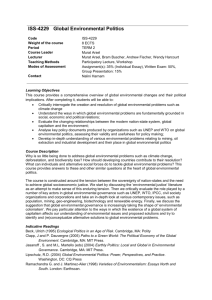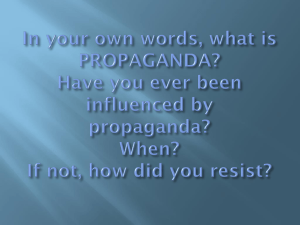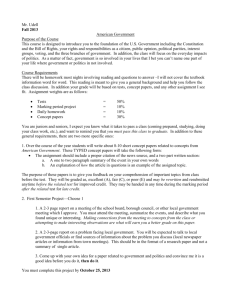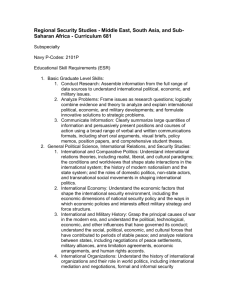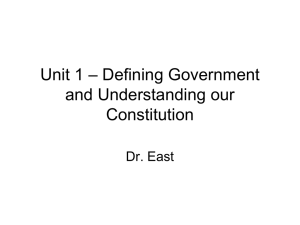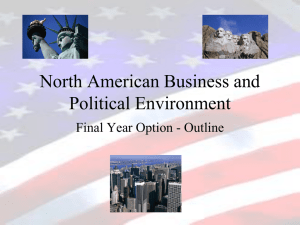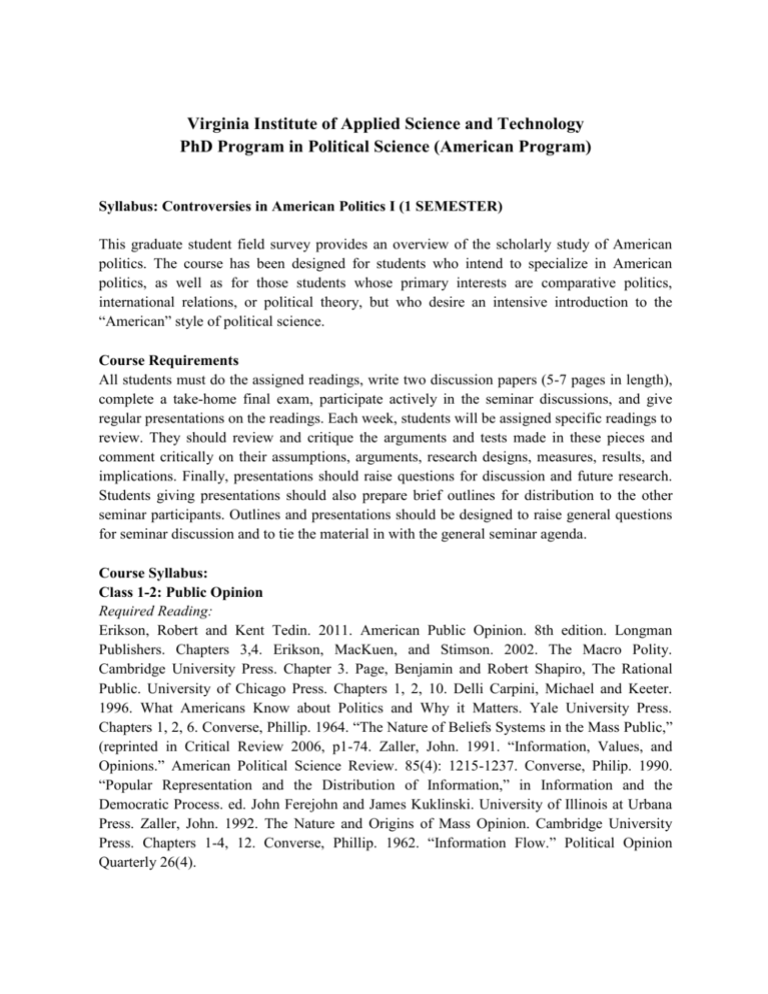
Virginia Institute of Applied Science and Technology
PhD Program in Political Science (American Program)
Syllabus: Controversies in American Politics I (1 SEMESTER)
This graduate student field survey provides an overview of the scholarly study of American
politics. The course has been designed for students who intend to specialize in American
politics, as well as for those students whose primary interests are comparative politics,
international relations, or political theory, but who desire an intensive introduction to the
“American” style of political science.
Course Requirements
All students must do the assigned readings, write two discussion papers (5-7 pages in length),
complete a take-home final exam, participate actively in the seminar discussions, and give
regular presentations on the readings. Each week, students will be assigned specific readings to
review. They should review and critique the arguments and tests made in these pieces and
comment critically on their assumptions, arguments, research designs, measures, results, and
implications. Finally, presentations should raise questions for discussion and future research.
Students giving presentations should also prepare brief outlines for distribution to the other
seminar participants. Outlines and presentations should be designed to raise general questions
for seminar discussion and to tie the material in with the general seminar agenda.
Course Syllabus:
Class 1-2: Public Opinion
Required Reading:
Erikson, Robert and Kent Tedin. 2011. American Public Opinion. 8th edition. Longman
Publishers. Chapters 3,4. Erikson, MacKuen, and Stimson. 2002. The Macro Polity.
Cambridge University Press. Chapter 3. Page, Benjamin and Robert Shapiro, The Rational
Public. University of Chicago Press. Chapters 1, 2, 10. Delli Carpini, Michael and Keeter.
1996. What Americans Know about Politics and Why it Matters. Yale University Press.
Chapters 1, 2, 6. Converse, Phillip. 1964. “The Nature of Beliefs Systems in the Mass Public,”
(reprinted in Critical Review 2006, p1-74. Zaller, John. 1991. “Information, Values, and
Opinions.” American Political Science Review. 85(4): 1215-1237. Converse, Philip. 1990.
“Popular Representation and the Distribution of Information,” in Information and the
Democratic Process. ed. John Ferejohn and James Kuklinski. University of Illinois at Urbana
Press. Zaller, John. 1992. The Nature and Origins of Mass Opinion. Cambridge University
Press. Chapters 1-4, 12. Converse, Phillip. 1962. “Information Flow.” Political Opinion
Quarterly 26(4).
Class 3-4: Political Participation
Required Reading:
Morton, Rebecca. 2006. Analyzing Elections. W. W. Norton. Chapter 2. (to be provided).
Downs, Anthony. 1957. “The Causes and Effects of Rational Abstention.” An Economic
Theory of Democracy. Addison Wesley Publishers. Chapter 14. Riker, William and Peter
Ordeshook. 1968. “A Theory of the Calculus of Voting.” American Political Science Review
62: 25-42. Aldrich, John. 1997. “When is it Rational to Vote?” Perspectives on Public Choice,
ed. Dennis Mueller. Cambridge University Press. Chapter 17. TBA. Niemi, Richard and
Herbert Weisberg. 2001. “Why is Turnout so Low (And Why is it Declining?)” Controversies
in Voting Behavior. 4th ed. CQ Press. Chapter 2. TBA. Putnam, Robert. 2001. “Tuning in,
tuning out: the strange disappearance of social capital in America.” Controversies in Voting
Behavior. 4th ed. CQ Press. Chapter 3. TBA. Wattenberg, Martin. 2002. Where Have All the
Voters Gone? Harvard University Press. Chapters 2, 3, 4, 8. Citrin, Jack. Eric Schickler, and
John Sides. 2003. “What if Everyone Voted? Simulating the Impact of Increased Turnout on
Senate Elections.” American Journal of Political Science. 47 (Jan): 75-90. Flanigan, William
and Nancy Zingale. 2003. “Suffrage and Turnout.” The Political Behavior of the American
Electorate. 10th ed. CQ Press. Chapter 2. Rosenstone, Steven J. and John Mark Hansen. 2001.
“Solving the Puzzle of Participation in Electoral Politics.” Controversies in Voting Behavior.
4th ed. CQ Press. Chapter 4. Franklin, Mark N. 2001. “Electoral Participation.” Controversies
in Voting Behavior. 4th ed. CQ Press. Chapter 5. TBA. Verba, Sidney, Kay L. Schlozman, and
Henry E. Brady. 1995. Voice and Equality: Civic Voluntarism in American Politics. Harvard
University Press. Chapters 16, 17.
Class 5-6: Voting and Elections
Required Reading:
Downs, Anthony. 1957. “The Statics and Dynamics of Party Ideologies.”An Economic Theory
of Democracy. Addison Wesley Publishers. Chapter 8. Fiorina, Morris. 1997. “Voting
Behavior.” Perspectives on Public Choice, ed. Dennis C. Mueller. Cambridge University
Press. Chapter 18. TBA. Erikson, Robert S., Michael B. MacKuen, and James A. Stimson.
2002. “Elections.” The Macro Polity. Cambridge University Press. Chapter 7. Fiorina, Morris,
Samuel J. Abrams, and Jeremy C. Pope. 2005. Culture War? The Myth of a Polarized
America. 2nd edition. Longman Publishers. Ansolabehere, Stephen, Jonathan Rodden, and
James M. Snyder. 2008. “The Strength of Issues: Using Multiple Measures to Gauge
Preference Stability, Ideological Constraint, and Issue Voting.” American Political Science
Review 102(2). Gelman, Andrew, Boris Shor, Joseph Bafumi, and Jeronimo Cortina. 2008.
Red State, Blue State, Rich State, Poor State: Why Americans Vote the Way They Do.
Princeton University Press. Niemi, Richard and Herbert Weisberg. 2001. “What Determines
the Vote?” Controversies in Voting Behavior. 4th ed. CQ Press. TBA. Alvarez, Michael .
1998. Information and Elections. University of Michigan Press. McKelvey, Richard and Peter
Ordeshook. 1990. “Information and Elections: Retrospective Voting and Elections.”
Information and Democratic Processes. ed. Ferejohn and Kuklinski. University of Illinois
Press. Chapter 12. Zaller, John . 1992. The Nature and Origins of Mass Opinion. Cambridge
University Press. Chapter 10. Campbell, Angus et al. 1960. The American Voter. University of
Chicago Press. Chapters 6, 10, 20. Campbell, Angus. 1964. “Voters and Elections, Past and
Present.” Journal of Politics 26(4): 745-757. Nie, Norman H., Sidney Verba, and John R.
Petrocik. 1976. The Changing American Voter. Replica Books. Chapters 10, 17, 18. Miller,
Warren E. and J. Merrill Shanks. “Multi-Stage Explanations of Political Preference.”
Controversies in Voting Behavior. 4th ed. CQ Press. Chapter 12. Lodge, Milton et al. “The
Responsive Voter: Campaign Information and the Dynamics of Candidate Evaluation.”
Controversies in Voting Behavior. 4th ed. CQ Press. Chapter 13. TBA. Erikson, Robert and
Kent Tedin. 2011. American Public Opinion. 8th ed. Longman Publishing Group. Chapter 9.
Class 7-8: Interest Groups and Political Parties
Required Reading:
Olson, Mancur. 1966. The Logic of Collective Action. Harvard University Press. Chapters 1,
2, 5, and 6. Green, Donald, Bradley Palmquist, and Eric Schickler. 2002. Partisan Hearts and
Minds. Yale University Press. Chapters 1-4. Walker, Jack. 1983. “The Origins and
Maintenance of Interest Groups in the United States.” American Political Science Review.
77(2): 390-406. Erikson, Robert S., Michael B., MacKuen, and James A. Stimson. 2001.
“Macropartisanship: The Permanent Memory of Partisan Evaluation.” Controversies in Voting
Behavior. 4th ed. CQ Press. Chapter 20. Aldrich, John and Richard Niemi. 2001. “The Sixth
Party System: Electoral Change 1952-1992.” Controversies in Voting Behavior. 4th ed. CQ
Press. Chapter 23. Niemi, Richard and Herbert Weisberg. 2001. Controversies in Voting
Behavior. 4th ed. CQ Press. Chapter 20, 23 (19 recommended). Aldrich, John. 1995. Why
Parties: The Origins and Transformation of Party Politics in America. University of Chicago
Press. Chapters 1, 2, 4. Niemi, Richard and Herbert Weisberg. 2001. “Is the Party System
Changing?” Controversies in Voting Behavior. 4th ed. CQ Press. Chapter 21. Niemi, Richard
and Herbert Weisberg. 2001. “How Much Does Politics Affect Party Identification?”
Controversies in Voting Behavior. 4th ed. Chapter 17. Green, Donald P., Bradley L.
Palmquist, and Eric Schickler. “Partisan Stability: Evidence from Aggregate Data.”
Controversies in Voting Behavior, 4th ed. Chapter 19. Stigler, George. 1988. “The Theory of
Economic Regulation,” Chicago Studies in Political Economy. University of Chicago Press.
Schelling, Thomas C. “Hockey Helmets, Daylight Saving, and Other Binary Choices,”
Rational Man and Irrational Society, eds. Brian Barry and Russell Hardin. Sage Publications.
Erikson, Robert, Michael MacKuen, and James Stimson. 2002. The Macro Polity. Cambridge
University Press. Chapters 4 and 5. Snyder, James M. Jr., Michael M. Ting. 2002. “An
Informational Rationale for Political Parties.” American Journal of Political Science, 4(1):90110.
Class 9-10: Courts
Required Reading:
Segal, Jeffrey, and Harold Spaeth. 2002. The Supreme Court and the Attitudinal Model
Revisited. Cambridge University Press. Chapters 3 and 8. Epstein, Lee, and Jack Knight. 1998.
Choices Justices Make. CQ Press. Preface and Chapters 1-3. Epstein, Lee, and Jack Knight.
2000. “Field Essay: Toward a Strategic Revolution in Judicial Politics: A Look Back, A Look
Ahead.” Political Research Quarterly. 53(3): 625-661. [Read up to page 641 and the
Discussion, skim the material in between]. Lax, Jeffrey R. 2011. “The New Judicial Politics of
Legal Doctrine,” Annual Review of Political Science, (Forthcoming May), 2011 [sections 1
and 2, the rest is optional) • Cameron, Charles M., Jeffrey A. Segal, and Donald Songer. 2000.
“Strategic Auditing in a Political Hierarchy: An Informational Model of the Supreme Court’s
Certiorari Decisions.” American Political Science Review. 94(1): 101-116. Lax, Jeffrey R.
2007. “Constructing Legal Rules on Appellate Courts: Median Rules Without a Median
Judge.” American Political Science Review. 101(3): 591-604. Fischman JB, Law DS. 2009.
“What is judicial ideology, and how should we measure it?” Journal of Law and Policy
29:133. Rosenberg, Gerald N. 1995. “The Real World of Constitutional Rights: The Supreme
Court and the Implementation of Abortion Decisions.” Contemplating Courts. ed. Lee Epstein.
Congressional Quarterly Press. – and his book, The Hollow Hope. Richards MJ, Kritzer HM.
2002. “Jurisprudential regimes in supreme court decision making.” American Political Science
Review 96:305–20. Lax, Jeffrey R., and Kelly T. Rader. 2010. “Legal Constraints on Supreme
Court Decision Making: Do Jurisprudential Regimes Exist?” Journal of Politics. Vol. 71-2
(April), 2010. Huber, Gregory A., and Sanford C. Gordon. 2004. “Accountability and
Coercion: Is Justice Blind when it Runs for Office?” American Journal of Political Science 48:
247-263. Lax, Jeffrey R. and Charles M. Cameron. 2007. “Bargaining and Opinion
Assignment on the U.S. Supreme Court.” Journal of Law, Economics, and Organization.
23(2): 267-302. Kornhauser, Lewis. 1999. “Appeal and Supreme Courts.” Encyclopedia of
Law and Economics. University of Ghent: http://encyclo.findlaw.com/7200book.pdf.
Rosenberg, Gerald. 1991. The Hollow Hope. University of Chicago Press. Jacobi, Tonja. 2006.
“The Impact of Positive Political Theory on Old Questions of Constitutional Law and the
Separation of Powers,” Northwestern Law Review 100(1): 259. Epp, Charles. The Rights
Revolution. University of Chicago Press. Chapters 2-4. Baum, Larry. 1998. The Puzzle of
Judicial Behavior. University of Michigan Press. Friedman, Barry. 2006. “Taking Law
Seriously.” Perspectives on Politics 4(2): 261-76. McNollgast, N. 1995. “Politics and the
Court: A Positive Theory of Judicial Doctrine and the Rule of Law.” Southern California Law
Review 68 (6): 1631-1684. Clark TS. 2011. The Limits of Judicial Independence. Cambridge
University Press.
Required readings
Cameron, Charles. 2000. Veto Bargaining: Presidents and the Politics of Negative Power.
Cambridge University Press. Canes-Wrone, Brandice. 2005. Who Leads Whom? Presidents,
Policy, and the Public. University Of Chicago Press. Delli Carpini, Michael and Scott Keeter.
1996. What Americans Know about Politics and Why it Matters. Yale University Press.
Downs, Anthony. 1957. An Economic Theory of Democracy. Harper and Row. Epstein,
David, and Sharyn O’Halloran. 1999. Delegating Powers: A Transaction Costs Politics
Approach to Politics under the Separation of Powers. Cambridge University Press. Erikson,
Robert and Kent Tedin. 2011. American Public Opinion, 8th ed. Pearson/Longman. Erikson,
Robert S., Gerald C. Wright, and John P. McIver. 1993. Statehouse Democracy. Cambridge
University Press. Erikson, Robert S., Michael B. MacKuen, and James A. Stimson. 2002. The
Macro Polity. Cambridge University Press. Fiorina, Morris P. Disconnect: The Breakdown in
American Politics. University of Oklahoma Press. Fiorina, Morris, Samuel J. Abrams, and
Jeremy C. Pope. 2005. Culture War? The Myth of a Polarized America. Longman. 2nd
Edition. Green, Donald, Bradley Palmquist, and Eric Schickler. 2002. Partisan Hearts and
Minds. Yale University Press. Krehbiel, Keith. 1998. Pivotal Politics. University of Chicago
Press. Krehbiel, Keith. 1991. Information and Legislative Organization. University of
Michigan Press. Mayhew, David. Partisan Balance: Why Political Parties Don't Kill the U.S.
Constitutional System (Princeton Lectures in Politics and Public Affairs). Princeton University
Press. Neustadt, Richard. 1990. Presidential Power: The Politics of Leadership. Free Press.
North, Douglass C. 1990. Institutions, Institutional Change, and Economic Performance.
Cambridge University Press. Olson, Mancur. 1965. The Logic of Collective Action. Harvard
University Press. Page, Benjamin and Robert Shapiro. 1992. The Rational Public. University
of Chicago Press. Peterson, Paul. 1981. City Limits. University of Chicago Press. Skowronek,
Stephen. 1982. Building a New American State. Cambridge University Press. Wattenberg,
Martin. 2002. Where Have All the Voters Gone? (Harvard University Press).

